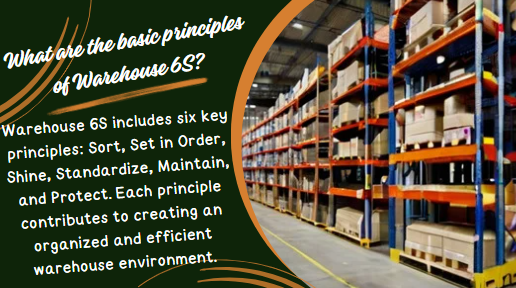Warehouse 6S – In the field of warehouse management, the chase for operational excellence is a constant effort. Efficiency, organization, and safety are important aspects that determine the success of any warehouse operation. Among the methods designed to achieve these goals, Warehouse 6S stands out as a comprehensive approach that combines the principles of the traditional 5S methodology with additional importance on security. In this in-depth exploration, we can find the core components of Warehouse 6S, its implementation strategies, benefits, and real-world applications.
- Understanding Warehouse 6S
- Six Pillars of Warehouse 6S
- Implementation of Warehouse 6S
- 6S execution
- Benefits of Warehouse 6S
- Real-world applications
- Conclusion
- Frequently Asked Questions:
- What is Warehouse 6S?
- What are the basic principles of Warehouse 6S?
- How does Warehouse 6S improve efficiency in warehouses?
- What is the difference between 5S and warehouse 6S?
- How is Warehouse 6S implemented in a warehouse setting?
- What are the benefits of adopting Warehouse 6S?
- How does Warehouse 6S contribute to safety in warehouses?
- Can Warehouse 6S be applied in various industries?
- What role do employees play in warehouse 6S implementation?
- How can a company measure the success of a warehouse 6S implementation?
Understanding Warehouse 6S

What is Warehouse 6S?
Warehouse 6S is an extension and improvement of the 5S methodology, which includes five key elements: sorting, setting in order, polishing, standardizing, and maintaining. Warehouse 6S retains these principles while introducing an additional ‘S’ for Security, thereby highlighting the vital role of security in warehouse operations. The goal of this method is to create an environment that promotes efficiency, organization, cleanliness, and, most importantly, safety.
Six Pillars of Warehouse 6S
Sort:
The process of classifying items within the warehouse. This involves removing unnecessary items, thus de-cluttering space and optimizing inventory management.
Set in order:
Systematic arrangement and organization of items after sorting. This step ensures that required items are easily accessible, reducing search time and improving workflow efficiency.
Shine:
Regular cleaning and maintenance activities aimed at maintaining cleanliness and functionality within the warehouse. A clean environment not only increases productivity but also contributes to safety.
Standardization:
Establishing standardized processes and practices throughout the warehouse. This step ensures consistency in operations, reduces errors, and facilitates a smooth workflow.
Sustain:
Implementing measures to ensure continued observance to established standards. Maintaining 6S principles involves training, monitoring, and fostering a culture of continuous improvement among employees.
Security:
Integrating security measures into every aspect of warehouse operations. This includes providing proper training, using proper safety equipment, and maintaining a safe work environment to prevent accidents and injuries.

Implementation of Warehouse 6S
Initial assessment and planning
Before implementing Warehouse 6S, it is important to conduct a comprehensive assessment of existing warehouse conditions. This evaluation identifies areas for improvement and sets the stage for planning the implementation process. Clear goal-setting and careful planning are fundamental to the success of this method.
6S execution
Implementation of Warehouse 6S involves a systematic approach:
Sort:
Categorize and remove unnecessary items.
Set in Order:
Arrange essential items in a logical and accessible way.
Shine:
Establish regular cleaning schedules and protocols.
Standardization:
Implement standardized processes and workflows.
Sustain:
Foster a culture of continuous improvement and accountability.
Safety:
Give priority to safety measures in all work.

Benefits of Warehouse 6S
Warehouse 6S delivers several benefits that positively impact warehouse operations:
Improved efficiency:
Streamlined processes result in faster operations and improved productivity.
Optimized space utilization:
Organizing and arranging to maximize available space for storage and operations.
Reduce waste and errors:
Standardized processes reduce errors and waste, leading to cost savings.
Improved safety:
Prioritizing safety measures reduces accidents and creates a safer work environment.
Employee Engagement:
Involving employees in the 6S process promotes ownership and increases morale.

Real-world applications
Warehouse 6S is not just a theoretical concept; its practical applications have shown remarkable changes in various industries. Case studies, testimonials, and success stories from businesses that have adopted Warehouse 6S can provide valuable insight into its implementation and impact.

Conclusion
Warehouse 6S includes a complete approach to warehouse management, integrating efficiency, organization, cleanliness, and safety into daily operations. By adopting and diligently implementing 6S principles, warehouses can experience increased productivity, lower costs, and, most importantly, a safer and more conducive work environment. Adopting Warehouse 6S is not just a methodology; it is a commitment to continuous improvement, setting the stage for continued success in the competitive landscape of modern warehouse management.
Click here for more topics.
Frequently Asked Questions:
What is Warehouse 6S?
Warehouse 6S is an advanced methodology for warehouse management, based on the traditional 5S approach (Sort, Set in Order, Shine, Standardize, Sustain) by adding ‘S’ for safety. It focuses on optimizing efficiency, organization, cleanliness, and safety in the warehouse environment.
What are the basic principles of Warehouse 6S?
Warehouse 6S includes six key principles: Sort, Set in Order, Shine, Standardize, Maintain, and Protect. Each principle contributes to creating an organized and efficient warehouse environment.
How does Warehouse 6S improve efficiency in warehouses?
By excluding confusion, organizing items systematically, maintaining cleanliness, standardizing processes, fostering a culture of continuous improvement, and prioritizing safety, Warehouse 6S optimizes workflow, reduces errors, and Increases overall productivity.
What is the difference between 5S and warehouse 6S?
Warehouse 6S is an extension of the 5S methodology, with the additional ‘S’ specifically emphasizing safety. While both focus on organizing and optimizing workplace efficiency, Warehouse 6S places more emphasis on creating a safe work environment.
How is Warehouse 6S implemented in a warehouse setting?
Implementation involves initial assessment, goal-setting, careful planning, and systematic execution of six principles: sort, set in order, shine, standardize, maintain, and protect. This requires commitment from all levels of the organization and a phased approach to implementation.
What are the benefits of adopting Warehouse 6S?
Warehouse 6S offers many benefits, including increased efficiency, optimized space utilization, reduced waste and errors, improved safety, increased employee engagement, and a culture of continuous improvement.
How does Warehouse 6S contribute to safety in warehouses?
Security is built into every aspect of Warehouse 6S. This includes implementing safety measures, providing proper training, using proper safety equipment, and maintaining a safe work environment to prevent accidents and injuries.
Can Warehouse 6S be applied in various industries?
Yes, Warehouse 6S principles are useful and can be applied across a variety of industries that involve warehouse operations, including manufacturing, logistics, retail, healthcare, and others. The flexibility of methodology allows adaptation to different environments.
What role do employees play in warehouse 6S implementation?
Employees play a vital role in the successful implementation of Warehouse 6S. Their active participation, commitment to following established processes, and contribution to continuous improvement are vital for sustained efficiency gains.
How can a company measure the success of a warehouse 6S implementation?
Success can be measured through various indicators such as improved productivity, reduction in errors and wastage, increased safety records, increased employee confidence, and consistent observance of standardized procedures.

Insightful. Very practical parameters to focus on managing and improving warehouse management.
With the right skills (people), workflow (processes) and systems (technology), this will be the recipe for efficiency.
Pingback: Lean Warehousing: Principles and Implementation Strategies